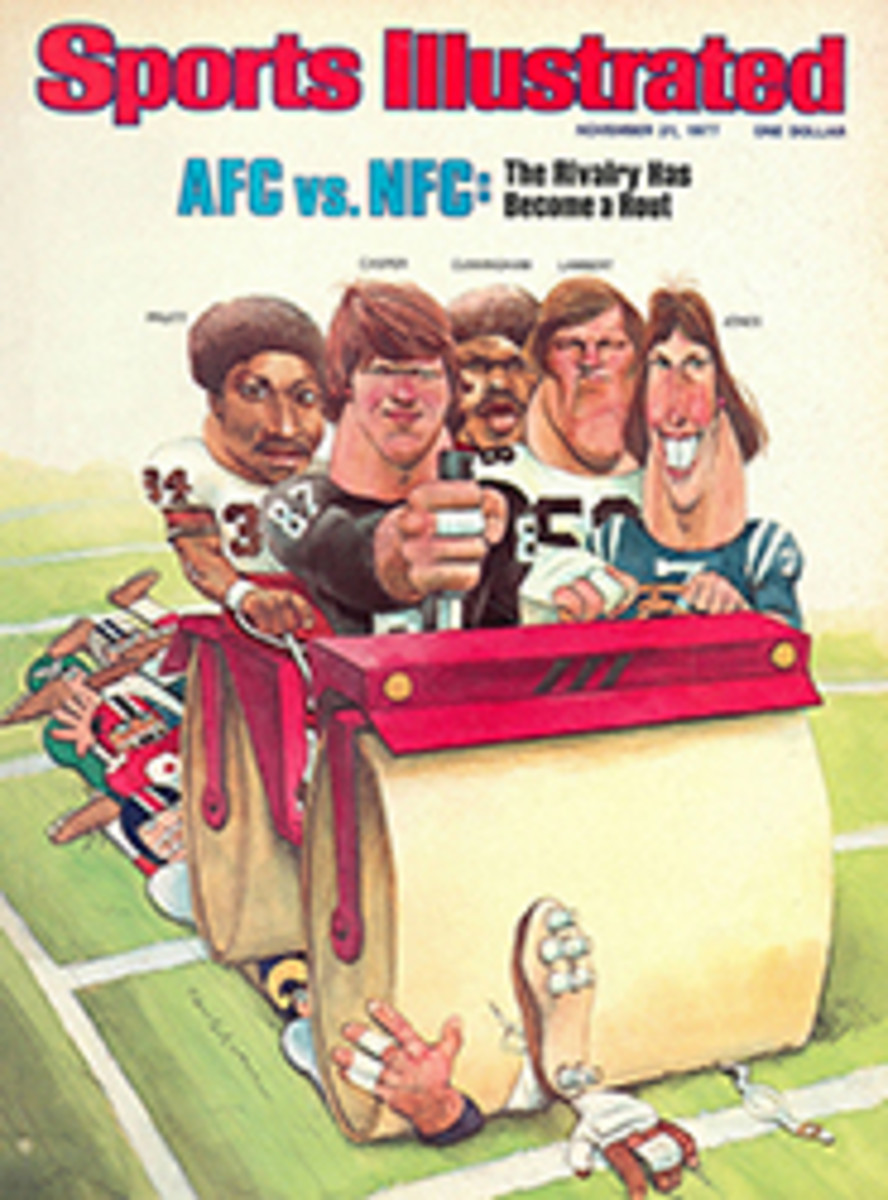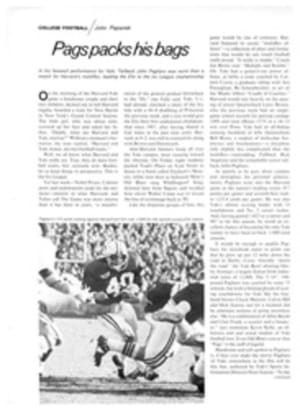
Taking a thrashing—and giving one
Through all its tangled and uncertain years the city of Key West has tried to be a perfect host to all kinds of people: octogenarians and libertarians; politicians and political refugees; tycoons and drifters; butchers, bakers and cigar makers. Despite its record of largesse, there has always been a tinge of deceit about Key West. The town has long boasted that it is frost-free in winter and always cooled by ocean breezes. Frost-free it is and perhaps ever shall be, but oh, those breezes. Instead of simply cooling the town, occasionally they almost knock it out cold, particularly when they get a running start out in the mid-Atlantic and are traveling at hurricane speed when they lift beach chairs into the air all over the island.
Of all the varied folk who have been exposed to an excess of wind in Key West in the last three years, the offshore powerboat crews who assemble annually for a race in November have had the worst of it. Two years ago, 24 hours after the U.S. Weather Service had forecast two days of bonny weather, the offshore racing men were busting along through 40-knot squalls and 10-foot seas, breaking bones, bruising egos and severely denting their bankrolls. Again last year the weather battled them, forcing officials to shorten the course to 114 statute miles—60 less than the minimum required for world championship points. Although earning points for the national title was incentive enough for almost every driver, they were still a suffering lot. Even on the shortened course that used the most protected waters, the drivers had the better part of 15 miles in 10-foot seas.
Last week the first real cold front of winter reached down across the Florida panhandle and stalled around St. Petersburg, waiting for race day in Key West. On the eve of race day the front moved into town. By starting time last Saturday, the wind at the Dry Tortugas, where the full-length race course of 183 miles turns back for home, was over 25 knots and the seas 12 feet. Of the nine drivers on hand to compete for the 1977 offshore world title in Class I (boats with a maximum displacement of 1,000 cubic inches), the happiest under the circumstances was Joel Halpern, the U.S. national champion. Two years ago in the Key West race—his debut in the high-powered open class—Halpern was second to the 1975 world champion, Wally Franz of Brazil. His boat was Beep Beep, a novel, very deep-V hull of narrow beam. In the same craft in the sloppy seas at Key West last year, he was again second to the world champion, Tom Gentry of Hawaii. This year he had a new Beep Beep, identical in configuration to the one in which he had chased world champions, won two national titles and earned the reputation as the very best of rough-water men. When last week's race was postponed from Saturday to Sunday, Halpern merely shrugged off the delay. "The boat is ready, the crew is ready, so all we can do is sit around and get nervous."
Because the Sunday forecast was for continuing high seas, Michael Doxford of England, the European offshore champion, was particularly downcast. The 35-foot Cigarette hull, Limit Up, in which he had won most of his glory in the past year, had been badly bashed in rough water in the last race of the European circuit. A dock strike had prevented the Cigarette from getting back to its home plant in Miami in time for repairs. As a consequence, Doxford was faced with the prospect of taking on Key West's short, steep swells in a tunnel catamaran, also called Limit Up, which appeared to have as much chance as a teak raft in the anticipated conditions. On Saturday, after the postponement was announced, and while the wind was still building white-caps on the shoals and blowing the wigs off some of the dollies on the streets of Key West, Halpern helpfully suggested to his English rival that he put a steering wheel in both the port and starboard hulls of the catamaran. The theory was that if the boat broke apart in the rough going, Doxford in one hull and navigator Tim Powell in the other would be able to complete the course separately.
Until this year the Key West offshore race served as a beginning and an end. It was the first race that counted for national title points in the upcoming year and the last race that counted for world championship points in the current year. There were about 20 races on five continents where world points could be earned, with drivers counting only their six or seven best performances regardless of how many races they had entered. Because some driver had usually locked up the world title well before November, the Key West race became a meaningless international event.
Two years ago, when he was president of the American Power Boat Association, Bob Nordskog, a 64-year-old Californian, proposed a different world title format to the International Motor-boating Union. With a mind to giving world competition the sort of uncomplicated pizzazz that might attract the unknowing public as well as cut the extreme cost of worldwide campaigning, Nordskog suggested that continental competitions be held, open to all comers, and that the three drivers with the best record on each continent meet in one race for the title. The idea was accepted and Key West was chosen as the first venue under the new system.
In any game so freakishly ridden with bad luck, a single race is a very shaky way to pick a world champ. But in defense of Nordskog's idea, not many drivers liked the old system. In the past, before the world circuit was half completed, the competition often had been reduced to a scrap between a pair of drivers—American, English or Italian—who had the talent, money, equipment and time to chase each other around the world in quest of the title. Don Aronow, the boat-builder, is the only American who ever tried seriously (and with success) to win both the U.S. and world titles the same year, and because Aronow has been a powerboat builder most of his life, his campaigning could hardly be said to have cut into his breadwinning. In contrast, Dr. Bob Magoon, the only man to win three consecutive U.S. titles, could never afford the time away from his surgery to campaign abroad.
For better or worse, it became "winner take all" at Key West. Although there are only three Class I boats operating in Australia, Peter Dean of Melbourne and Arnold Glass of Sydney (who failed this year to even finish a race Down Under) were undismayed at the prospect of meeting four Yanks, an Englishman and two Italians who had been scrapping hard through a long season to earn their berths. Nordskog, who had gone to South America to qualify in an attempt to stimulate competition down there, rated himself a doubtful winner because his new, light Kevlar hull was not proving as tractable as he liked in rough water.
On the eve of the race, Joe Ippolito, the rookie who had placed second to Halpern on the U.S. circuit, also became an unlikely choice as winner. His crewmen, Richie Powers and Bob Beich, had toiled more than 100 hours a week for a month trying to get a new 38-foot, lightweight Scarab hull completed, but failed, Beich passing out from exhaustion two days before the race. As a consequence, Ippolito took off for the starting line in a 35-footer that would not reach across the steep crests as well as the Scarab. Betty Cook, the only grandmother in the game, who finished third on the U.S. circuit driving a Scarab similar to the one Ippolito wanted to use, seemed to have as good a chance as anybody. Although the two Italians, Guido Niccolai and Francesco Cosentino, were somewhat doubtful about how they and their English-designed, Italian-built aluminum boats would behave in steep seas, Jack Stuteville, the U.S. throttleman for Niccolai, exuded confidence as readily as he did tobacco juice. "In six-to 10-foot water," he said between spits, "all these big hulls are going to be about the same. It'll get down to who has the most hair on his chest."
Although he has vast experience in offshore racing, Stuteville turned out to be dead wrong. On a shortened, 127-mile course the rough-and-tumble waters, which Stuteville had maintained would be an equalizer, brought a different kind of grief to almost every boat, and the world title went not to the hairiest man but to Betty Cook. In Kaama she thumped over the rock-hard water at an average of 54.9 mph, beating her nearest rival, Halpern, who had trim-control problems through much of the race, by 16 miles.
Dean, the Melbournite, was the first to take a bad lick from the sea. Just two miles after the start, he swapped ends, damaging his steering linkage so badly he was compelled to run the rest of the way at an average speed of 38 mph, using his trim tabs for control. Shortly thereafter Glass, the Sydneyite, quit, having hit a reef and busted an outdrive. Doxford in his ill-suited tunnel hull was the next to retire, forced out when the connecting rod tore loose from one of his widely separated outdrives.
The two Italian hulls, all-purpose wonders though they may be, behaved poorly in the skittery conditions. After leaping erratically from one seven-foot crest to the next, they would suddenly plow into a stray 10-footer and rocket skyward as if moon bound. Twenty-five miles from the start Cosentino withdrew with a badly gashed face. Feeling ill, Niccolai instructed Stuteville to complete the course at an easier pace. When his light and bouncy Kevlar hull proved as unsuited for the course as he suspected it might. Nordskog also backed off, satisfied to finish. After a two-foot crack opened in his little secondhand hull in the first 15 miles, Ippolito carried on, lead-footing it for another 15, until a fuel tank ruptured.
It was not carnage—just one of those days with enough minor disasters for everybody except Betty Cook, who in the last 50 miles was the only one still traveling at a champion's pace. Savoring the sweetest victory of her two-year career, Cook observed, "I have always said Key West is the worst course we run, but I think I could learn to love it."
PHOTO
Pounding through 10-foot waves at 54.9 mph, Cook was battered like her foes, but a buoyant victor.

